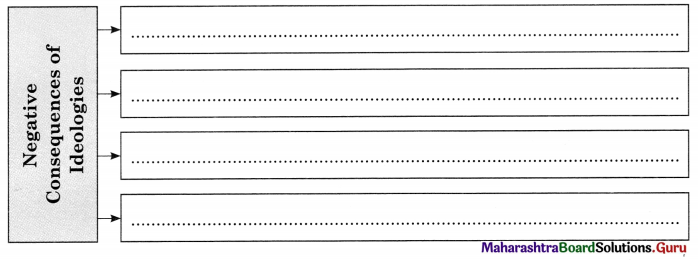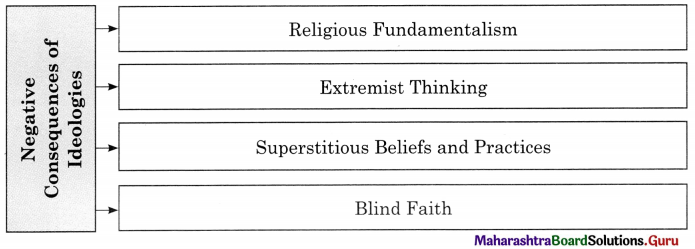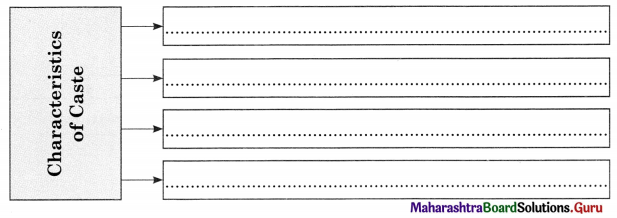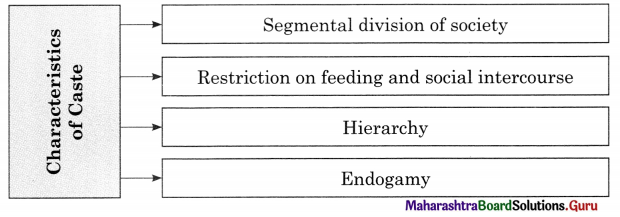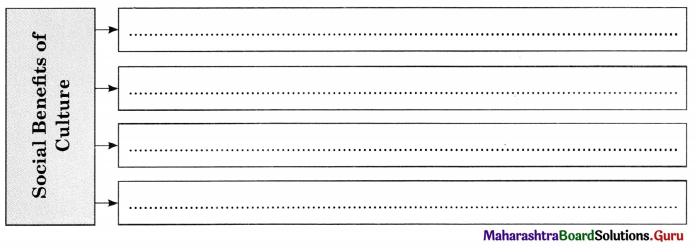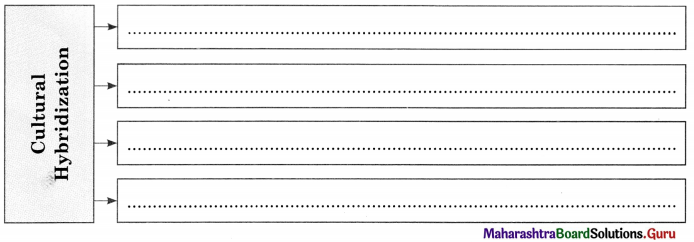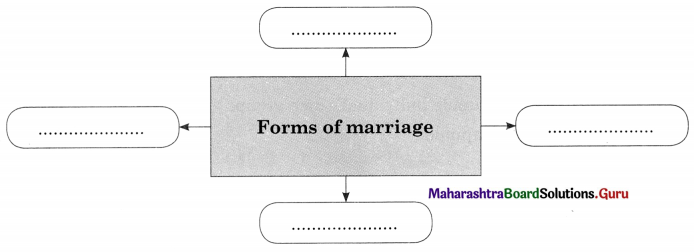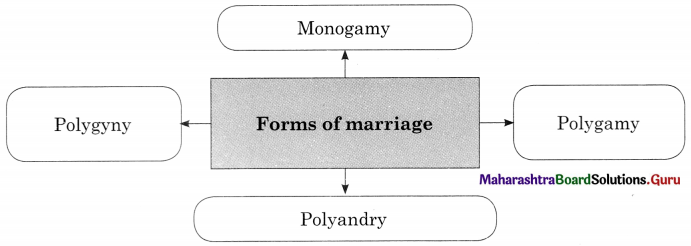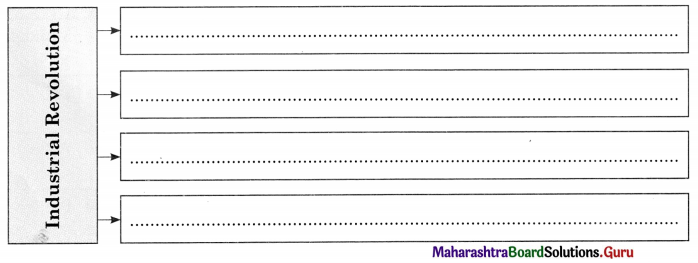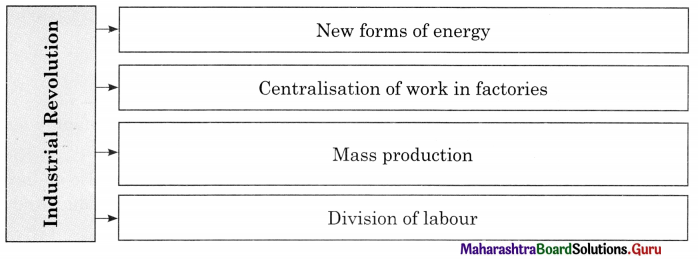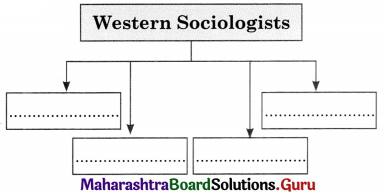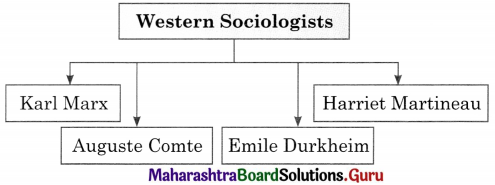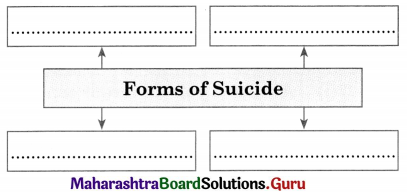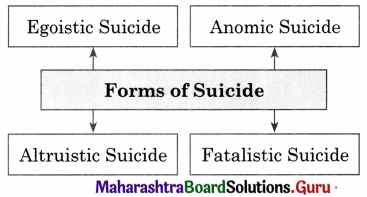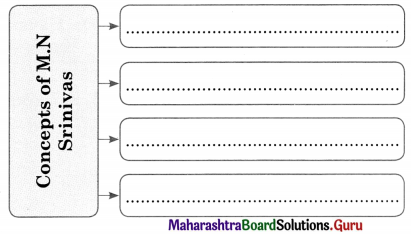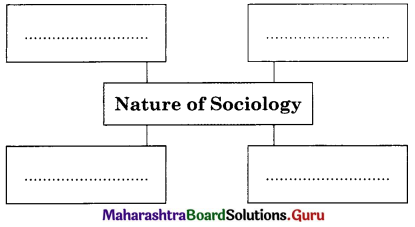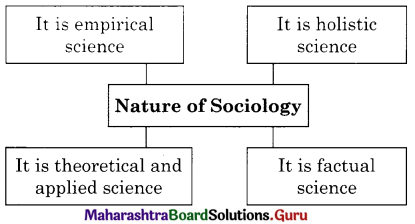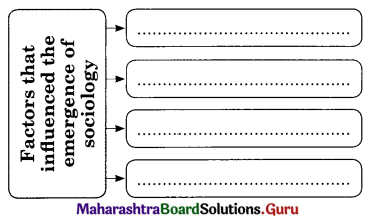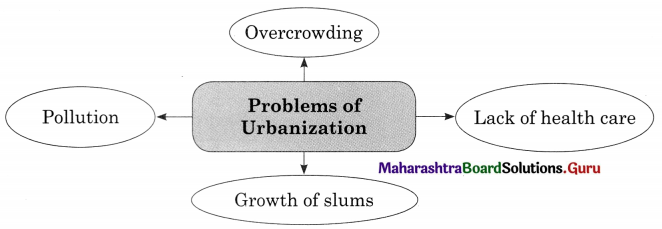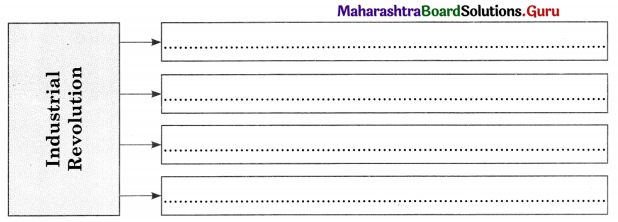Balbharti Maharashtra State Board 11th OCM Important Questions Chapter 2 Trade Important Questions and Answers.
Maharashtra State Board 11th Commerce OCM Important Questions Chapter 2 Trade
Select the correct option and rewrite the sentence
Question 1.
A retailer purchase goods from ……………….
(a) wholesaler
(b) producer
(c) customer
Answer:
(a) wholesaler
Question 2.
One price shop sells the goods at ………………. price.
(a) high
(b) low
(c) fixed
Answer:
(c) fixed

Question 3.
There is no salesman in the ………………. shop.
(a) Departmental
(b) Supermarket
(c) Chain stores
Answer:
(b) Supermarket
Question 4.
Maximum shopping convenience is available to the customers at ……………….. Stores.
(a) Departmental
(b) Chain
(c) One price
Answer:
(a) Departmental
Match the pairs
Question 1.
| Group A |
Group B |
| (a) Cheap Jacks |
(1) Pre-import stage |
| (b) Export |
(2) Trade within the country |
| (c) Shipment Advice |
(3) Permanent stalls |
| (d) Street traders |
(4) Particular line of goods |
| (e) Speciality shops |
(5) Changing place of business |
|
(6) Selling goods to other countries |
|
(7) Situated near residential areas |
|
(8) Moving from market to market |
|
(9) Selling on busy Streets |
|
(10) Import stage |
Answer:
| Group A |
Group B |
| (a) Cheap Jacks |
(5) Changing place of business |
| (b) Export |
(6) Selling goods to other countries |
| (c) Shipment Advice |
(1) Pre-import stage |
| (d) Street traders |
(8) Moving from market to market |
| (e) Speciality shops |
(4) Particular line of goods |
Question 2.
| Group A |
Group B |
| (a) Speciality Shop |
(1) Goods of higher prices |
| (b) Departmental Store |
(2) One line of particular product |
| (c) Market Trader |
(3) Most common shop |
| (d) General Shop |
(4) Fixed Prices |
| (e) One price shop |
(5) Business in market days |
|
(6) Not fixed price |
|
(7) Carry goods on head |
|
(8) Carry goods on cart |
|
(9) Fluctuating price |
|
(10) Goods of lower price |
Answer:
| Group A |
Group B |
| (a) Speciality Shop |
(2) One line of particular product |
| (b) Departmental Store |
(1) Goods of higher prices |
| (c) Market Trader |
(5) Business in market days |
| (d) General Shop |
(3) Most common shop |
| (e) One price shop |
(4) Fixed Prices |
Question 3.
| Group A |
Group B |
| (a) Wholesaler |
(1) Purchases goods from wholesaler |
| (b) Retailer |
(2) Link between manufacture and retailer |
| (c) No salesmen |
(3) Purchase goods from agents |
| (d) Speciality shops |
(4) Trade in same country |
| (e) Internal Trade |
(5) Specialised goods |
|
(6) Super market shop |
|
(7) Departmental Stores |
|
(8) General Goods |
|
(9) Trade with different countries |
|
(10) General Stores |
Answer:
| Group A |
Group B |
| (a) Wholesaler |
(2) Link between manufacture and retailer |
| (b) Retailer |
(1) Purchases goods from wholesaler |
| (c) No salesmen |
(6) Super market shop |
| (d) Speciality shops |
(5) Specialised goods |
| (e) Internal Trade |
(4) Trade in same country |
Give one word/phrase/term
Question 1.
A store where different shops are located under one roof.
Answer:
Departmental stores
Question 2.
The ultimate persons who is in need of goods.
Answer:
Consumers

Question 3.
The last link in the chain of distribution.
Answer:
Retailer
Question 4.
A trader who purchases goods from wholesalers.
Answer:
Retailer
Question 5.
A trade activity conducted between two or more countries.
Answer:
Import/Exports
Question 6.
The agent who has to make payment to customs authorities.
Answer:
Clearing and Forwarding agent
Question 7.
The shop where only specialized goods are sold.
Answer:
Speciality shops
Question 8.
A seller who links the manufacturers and retailers.
Answer:
Wholesaler
Question 9.
A store where day to day required goods are sold.
Answer:
General stores
Question 10.
A trader dealing in large quantity and in particular line of goods.
Answer:
Wholesaler
Question 11.
A trader who operates in a central market.
Answer:
Wholesaler
Question 12.
A person who buys in bulk and sells in small quantities.
Answer:
A wholesaler
Question 13.
The trader who stabilizes the prices.
Answer:
A wholesaler
Question 14.
The first link in the system of distribution.
Answer:
A wholesaler
Question 15.
A trader who sells goods in small quantities.
Answer:
A retailer
Question 16.
Retailers who carry goods on head or back.
Answer:
Peddlers
Question 17.
Retailers who carries goods on pack animal or hand cart or wheeled cart.
Answer:
Hawkers
Question 18.
A retailer who hire place of business on temporary basis.
Answer:
Cheap Jacks

Question 19.
Retailer who sells goods preferably in residential areas at fixed place.
Answer:
General Stores
Question 20.
A person who moves from place to place to sell goods.
Answer:
Mobile Retailers
Question 21.
A retail shop which operates through branches.
Answer:
Chain Shop
Question 22.
A shop where there are no salesman.
Answer:
Super Market
Question 23.
A store where many speciality shops are located under one roof.
Answer:
Departmental store
Question 24.
A shop where all the goods are available at same fixed prices.
Answer:
One price shop.
State True or False
Question 1.
Retailer is the first link in the chain of distribution.
Answer:
False
Question 2.
Chain stores requires very less financial investment.
Answer:
False
Question 3.
A wholesaler purchases small quantities of goods.
Answer:
False
Question 4.
A wholesalers is a connecting link between retailer and consumer.
Answer:
False
Question 5.
Retailers operate in wholesale markets.
Answer:
False
Question 6.
Departmental stores provide credit.
Answer:
False
Question 7.
The wholesaler can be eliminated.
Answer:
False
Question 8.
Wholesalers turnover is less.
Answer:
False
Question 9.
A retailer sells goods in bulk quantities.
Answer:
False
Question 10.
Peddlers carry their goods on hand carts.
Answer:
False
Question 11.
The market trader sells goods only on particular days.
Answer:
True

Question 12.
A retailer attends to customers personally.
Answer:
True
Question 13.
A retailer is indifferent to customers needs.
Answer:
False
Question 14.
The cheap jack does not have a permanent place.
Answer:
True
Question 15.
Street stall holders are permanent established shop keepers.
Answer:
False
Question 16.
Departmental stores approach customers.
Answer:
False
Question 17.
Chain stores deal in variety of goods.
Answer:
False
Question 18.
Supermarkets are known as Cash and Carry stores.
Answer:
True
Question 19.
One price shops sell low priced articles.
Answer:
False
Question 20.
Self-service is the features of super market.
Answer:
True
Question 21.
Departmental stores prefer central location.
Answer:
True
Find the odd one.
Question 1.
Super Market Shop
Big Bazaar, D-mart, Bata Stores, Reliance Fresh.
Answer:
Bata Stores
Question 2.
Chain Stores:
Bata Stores, Raymond Stores, Vijay Sales, Reliance Fresh.
Answer:
Reliance Fresh
Question 3.
Features of One Price Shop
Uniform Price, Credit Sales, Low Price, Less Capital.
Answer:
Credit Sales,
Question 4.
Shipment stage
Shipment Advice, Processing Document, Examination of Goods, Leading of Goods.
Answer:
Shipment Advice
Question 5.
Import stage
Receipt of Document, Bill of Entry, Delivery Order, Exporter Payment.
Answer:
Exporter Payment
Question 6.
Peddlers
Household Articles, Vegetable, Fish, Soap
Answer:
Household Articles

Question 7.
Fixed Shop Retailers
Supermarket Stores, Authorized Dealer, Speciality Shop, Cheap Jacks.
Answer:
Cheap Jacks.
Complete the sentences.
Question 1.
First link in the chain of distribution is ……………….
Answer:
Wholesaler
Question 2.
The retailer provides information of the market to the wholesaler and ……………..
Answer:
consumer
Question 3.
Market traders and street traders are …………………. retailers.
Answer:
Itinerant
Question 4.
Wholesaler links and ……………….
Answer:
producer and consumer
Question 5.
Wholesaler operates in ……………….. market.
Answer:
central
Question 6.
Wholesaler helps to ………………. prices.
Answer:
stabilise
Question 7.
Internal trade can be divided into ………………… and Retail trade.
Answer:
Wholesale trade
Question 8.
Retail trade is restricted to ………………… area.
Answer:
local
Question 9.
The person who conducts the retail trade is known as ………………..
Answer:
retailer
Question 10.
The hawkers carry the goods in …………………
Answer:
wheel carts
Question 11.
Speciality shop deals in ……………….. goods.
Answer:
particular line of goods
Question 12.
Chain shop sells goods at ………………… prices.
Answer:
fixed
Question 13.
Street stall holder is a type of ………………….
Answer:
Type of Small Scale Retailer
Question 14.
Mobile retailers have no …………………. shop.
Answer:
fixed
Question 15.
The peddlers carry the goods on their ………………. or ……………….
Answer:
back or head
Question 16.
Peddlers are ………………….. retailers.
Answer:
mobile
Question 17.
One price shops sells goods at ………………. price.
Answer:
one
Question 18.
Supermarket resemble ……………….
Answer:
Departmental stores.
Select the correct option
Question 1.
Hawkers are (mobile / immobile) retailers.
Answer:
mobile

Question 2.
Retailer sell (small / large) quantity of goods.
Answer:
small
Question 3.
Price in one price shops are (fixed / different).
Answer:
fixed
Question 4.
Wholesaler purchase goods on (small / large) scale.
Answer:
large
Question 5.
Retailer is (first / last ) link in the chain of distribution.
Answer:
last
Question 6.
Departmental store requires (large / small) capital.
Answer:
large
Question 7.
Chain store operate (inside /outside) the city.
Answer:
inside
Question 8.
Trade between two states or cities is called (internal / external) trade.
Answer:
internal
Question 9.
The person engaged in wholesale trade is known as (retailer / wholesaler)
Answer:
Wholesaler
Question 10.
A wholesaler maintains price (instability / stability)
Answer:
stability
Question 11.
(Manufacturers / Retailers) get direct information from wholesalers.
Answer:
Manufacturers
Question 12.
Retailers are normally situated (residential / non-residential) areas.
Answer:
residential
Question 13.
Supermarket Stores is a (small scale / large scale) fixed retailer.
Answer:
large scale
Question 14.
Peddlers carry goods in (baskets / hand cart)
Answer:
baskets
Question 15.
Market Traders are also called as (weekly / monthly) market.
Answer:
weekly
Question 16.
Chain stores are owned by (multiple / single) organization.
Answer:
single
Question 17.
Sale of goods and services to foreign country is called (export / internal trade)
Answer:
export.
Answer in one sentence
Question 1.
What do you mean by trade?
Answer:
Buying and selling of goods or services with an object to earn profit is called a trade.
Question 2.
Who creates link between producers and consumers?
Answer:
Trade creates link between producers and consumers.
Question 3.
Name the channel of distribution in trade?
Answer:
Channel of distribution in trade consists of Producer to Wholesaler, Wholesaler to Retailer and Retailer to Consumer.
Producer → Wholesaler → Retailer → Consumer
Question 4.
What is wholesale trade?
Answer:
Buying of goods from manufacturer or producer in large quantities is called as wholesale trade.

Question 5.
Name the marketing functions of wholesaler.
Answer:
The marketing functions of wholesaler includes assembling, warehousing, transporting, grading, packing, advertising and financing.
Question 6.
Define Retail Trade.
Answer:
According to William Stanton – “Retail trade includes all activities directly related to the sale of goods and services to the ultimate consumer for personal and non-business use”.
Question 7.
Who is retailer?
Answer:
A person engaged in retail trade is called as retailer.
Question 8.
Name the oldest type of retailers.
Answer:
The oldest type of retailers are – Hawkers and Peddlers.
Question 9.
Who are street traders?
Answer:
Retailers doing business as footpaths of busy streets of cities and towns are called as Street traders.
Question 10.
Who are itinerant retailers?
Answer:
Itinerant retailers are those retailers who do not have a fixed place or fixed shop for their business.
Question 11.
Who are fixed shop retailers?
Answer:
Retailers who do not move from one place to another for selling their goods are called fixed shop retailers.
Question 12.
Give examples of super market shop.
Answer:
Examples of super market shops are – Big Bazaar, D-mart, Reliance fresh, etc.
Question 13.
What is international trade?
Answer:
Trading activities conducted between two or more countries is called as international trade.
Question 14.
Name the stages involved in export trade.
Answer:
The stages involved in export trade are Preliminary Stage, Pre-shipment Stage, Shipment Stage and Post Shipment Stage.
Question 15.
What is letter of credit?
Answer:
Letter of credit is a letter given by importers bank showing the credit worthiness of the importer.
Question 16.
Who is C & F agent?
Answer:
C & F agent is a custom house agent who is responsible for forwarding of goods in export procedure.
Question 17.
What is entrepot trade?
Answer:
Entrepot trade is referred to as a seaport or warehouse where goods are imported for storage or process before re-export.
Correct the underlined word and rewrite the following sentences
Question 1.
Fixed shop retailers do not have fixed place of business.
Answer:
Itinerant shop retailers do not have fixed place of business.
Question 2.
Itinerant retailers give credit facility to customer.
Answer:
Itinerant retailers do not give credit facility to customer.
Question 3.
General Store spend more an advertisement.
Answer:
Speciality shop spend more an advertisement.
Question 4.
Cost of operating is very high in Chain store.
Answer:
Cost of operating is very high in Departmental store.

Question 5.
A person who does wholesale business is called retailer.
Answer:
A person who does retail business is called retailer. .
Question 6.
Internal trade is affected bv tariff rates of various countries.
Answer:
Foreign trade is affected by tariff rates of various countries.
Question 7.
Retailer is first link in chain of distribution.
Answer:
Retailer is last link in chain of distribution.
Question 8.
Shopper Shop is an example of small scale fixed retailers.
Answer:
Medical Store is an example of small scale fixed retailers.
Question 9.
Market Traders have their independent shops having temporary setup.
Answer:
Cheap Jacks have their independent shops having temporary setup.
Question 10.
Cheap jacks sells fruits, tovs. daily utensil, etc.
Answer:
Cheap jacks sells cutlery, crockery, socks, etc.
Question 11.
General Stores sells second hand and used goods.
Answer:
Second hand goods shops sells second hand and used goods.
Question 12.
Speciality shops have authorised dealership of particular manufacturer’s goods.
Answer:
Authorised dealers have authorised dealership of particular manufacturer’s goods.
Question 13.
Cheap Jacks accepts credit cards payment.
Answer:
Departmental Stores accepts credit cards payment.
Question 14.
Modern shopping mall is an African term.
Answer:
Modern shopping mall is an American term.
Question 15.
Export trade refers to purchase of goods and services to foreign country.
Answer:
Export trade refers to sale of goods and services to foreign country.
Arrange in proper order
Question 1.
Import License, Registration, Follow up, Bill of Entry.
Answer:
Registration, Import License, Bill of Entry, Follow up.
Question 2.
Purchase, Selling, Transport, Storage.
Answer:
Purchase, Transport, Storage, Selling.
Question 3.
Presentation of Documents, Follow-up, Shipment Advice, Realization of Export Incentive.
Answer:
Shipment Advice, Presentation of Documents, Realization of Export Incentive, Follow-up.
Question 4.
Preshipment Finance, Receipt of Order, GST formalities, ECGC Cover.
Answer:
Receipt of order, Preshipment finance, ECGC Cover, GST formalities.
Question 5.
Order Placement, Shipment Advice, Quota Certificate, Letter of Credit.
Answer:
Quota Certificate, Order Placement, Letter of credit, Shipment Advice.
Explain the following terms /concepts.
Question 1.
Online Retail Trade.
Answer:
- It is a modern form of trade which is done through internet.
- It is becoming move popular in Indian market.
- It saves time and cost of management.
- E.g. Flipkart, Amazon, Shop clues, Myntra, etc.
Question 2.
Hawkers.
Answer:
- It is oldest types of retailers.
- They move from place to place, carrying goods in hand cart.
- It requires limited capital.
- They deal in seasonal vegetables, fruits, etc.
Study the following case/situation and express your opinion.
1. A bazar where in old books are sold is organized every Saturday on the streets of Fort, Mumbai.
Question 1.
Name this form of retailing.
Answer:
Market Traders, a form of Itinerant retailer.
Question 2.
What is market traders also called as?
Answer:
It is also called as “weekly market”.
Question 3.
Give an example of such market.
Answer:
Jumma Bazaar in Mumbai, is an e.g. of such markets.

2. Tata have opened CROMA store in different locations. These stores sell consumers electronic items.
Question 1.
Name these type of retail trade?
Answer:
Speciality shops
Question 2.
Which type of retailer are they?
Answer:
Small Scale Fixed retailer.
3. Mr. Ashutosh wants to do multiple shoppings – like groceries, stationery, clothes, etc. He visited Big Bazarsituated near his home and his requirement were fulfilled.
Question 1.
What kind of retail store in Big-bazaar.
Answer:
Big Bazaar is a kind of super market.
Question 2.
What is a feature of super market?
Answer:
It is a large retail organisation selling wide variety of food, groceries and many other consumer goods.
Question 3.
Give an e.g. of other such stores.
Answer:
Other such stores found are D-mart, Reliance fresh, etc.
Distinguish between the following
Question 1.
Departmental Store and Super Market Store.
Answer:
|
Departmental Store |
Super Market Store |
| (1) Meaning |
It is a large scale retail shop having different departments and sections for different types of goods. |
It is a large scale retail organisation which sells a wide variety of goods to the customers on basis of self service. |
| (2) Capital |
Requires large scale of capital |
Requires less capital than departmental store. |
| (3) Articles sold |
Customers belonging to high and middle income class. |
Customers are belonging to all types of classes. |
| (4) Utility |
Prices of goods are generally higher than market price. |
Prices of goods are generally lower than market price. |
| (5) Salesman |
Goods are sold by Salesman. |
There is no salesman for sale. |
Answer in brief.
Question 1.
Explain the post import stage of import.
Answer:
Various duties have to paid in order to take the goods out of port are:
- Port Trust Dues : The clearing and forwarding agent has to make the payment of port trust dues.
- Customer Duty : Also paid by the clearing and forwarding agent to the custom authorities.
- Insurance Premium : Under the FOB (Free of Board) impact, the importer has to make the payment of Insurance Premium.
- Payment of Freight : The shipping contract will lay down the amount of freight to be paid and it has to be paid by the importer for getting clearance of goods.
- Exporters Payment : The exporter draws a Bill of Exchange on the importer according to the terms and conditions of the contract.
- Follow Up : It is the duty of the importer to take a follow up of the goods. If there are any discrepancies in the order or goods it has to be intimated to the exporter. Thus, the procedure of importing goods comes to an end.
Question 2.
Explain the pre-shipment stage of export procedure.
Answer:
- Receipt of Order : When the exporter receives an order he has to check the details of the order. He also check the restriction of import in the importer’s country.
- Letter of Credit : The exporter has to obtain a letter of credit from the importer, which is used to clear the foreign exchanges and other restrictions.
- Pre-shipment Finance : The exporter has to meet his working capital needs and for that he has to obtain the pre-shipment finance from his bankers.
- Production of goods : If the exporter is a manufacturer, then he has to produce the goods according to the order placed by the importer, otherwise he has get the necessary goods arranged from his suppliers.
Justify the following statements
Question 1.
The wholesaler cannot be eliminated.
Answer:
- Wholesaler act as a link between the manufacturer and the retailer.
- The wholesaler performs different functions in the process of distribution of goods and services.
- They enable the producer to reach consumers spread over the nation.
- Thus, wholesaler cannot be eliminated.
Question 2.
Wholesaler is not the last link in the channel of distribution.
Answer:
- Wholesaler buys goods from the manufacturer in large scale and sells the goods to the retailers as per their requirement.
- Retailer is the last link in the chain of distribution.
- Wholesaler acts as an middlemen.
- The wholesaler acts as a link between the manufacturer and the retailer.
- Thus, wholesaler is not the last link in the chain of distribution.

Question 3.
There is need of retailer in case of perishable goods.
Answer:
- In case of perishable goods retailer act as a. very important factor.
- Because the life of perishable goods is very less there is no possibility of moving goods from producer to wholesaler and then to retailer.
- Retailers directly sells the perishable goods to customers.
- Thus, there is need of retailer in case of perishable goods.
Question 4.
The cheap jack does not have a permanent place.
Answer:
- Cheap Jacks are mobile retailers.
- They hire temporary places for business in residential areas.
- If they do not get good response they move to other places.
- Thus, the cheap jack does not have a permanent place.
Question 5.
Retail prices are higher than wholesale prices.
Answer:
- Retail price are always higher than wholesale price.
- Retailer purchases goods from wholesaler then he adds his profit and finally he sells it to-the customers.
- Thus, retail price is higher than wholesale price.
Question 6.
Cheap Jacks are not reliable and dependable.
Answer:
- Cheap Jacks are mobile retailers.
- They do not have fixed place of business. They hire temporary place of business in residential area for short period.
- They go on changing their place of business.
- Thus, they are not reliable and dependable.
Question 7.
There is limited choice to customers in a chain shop.
Answer:
- Chain stores have limited range of goods.
- Each branch of chain stores deal in same commodity or in the same line of products.
- Thus, there is limited choice to customers.
Question 8.
Departmental stores is a collection of speciality shops under one roof.
Answer:
- Departmental stores is a large scale organization situated in central place and divided into several departments.
- Each department deals in on or two lines of goods.
- Thus, there is a collection of speciality shops under one roof.
Question 9.
Purchases in chain shops are centralized.
Answer:
- In chain shops the head office buys the product on a large scale and then distributes them to the branches.
- The branches sells the goods by following a common sales policy.
- There is centralised buying and decentralised selling.
- Thus, purchases in chain shops are centralized.
Question 10.
Super markets sell all types of goods.
Answer:
- Super market sells wide variety of goods.
- The types of articles generally sold by supermarkets are goods of everyday necessities like fruits, stationery, cutlery, etc.
- At times goods which are not available with small retailers are available in super market.
- Thus, super markets sell all types of goods.
Question 11.
Self-service is the features of super market.
Answer:
- Supermarket is a large scale retail organization specialising in necessaries and convenience goods.
- There is no salesman or sales assistants.
- The customers themselves are guides to their shopping efforts. Therefore, supermarkets are called “self service stores”.
- Thus, self-service is the features of super market.
Question 12.
Super market shops do not offers home delivery facilities to customers.
Answer:
- Supermarket does not give home delivery facility.
- In supermarket there are no salesman or assistants also.
- Consumers themselves assembles the goods on a wheeled trolley and at the gate customer is billed and charged for the goods. They carry goods themselves.
- Thus, super market shops do not offers home delivery facilities to customers.
Question 13.
Retailer in a link between manufacturer and wholesaler.
Answer:
- Retailer is a link between wholesaler and customer.
- Retailer is the last link in the chain of distribution.
- They come in direct contact with customers. They also purchase goods from wholesaler and comes in direct contact with him.
- Thus, retailer in a link between manufacturer and wholesaler.

Attempt the following.
Question 1.
Explain any four services of wholesalers to retailers.
Answer:
- Financial Support : Wholesaler provides credit facility, discount facility and financial assistance to their retailers.
- Market Information : Wholesaler provides market information to retailers as he has link with various manufacturers. This information is very useful to retailers for purchase of goods.
- Risk Bearing : Retailer holds limited stock of goods and avoids the risk of spoilage of goods. Retailer get protected from increase or decrease of prices of goods and fluctuation of demand.
- Stock of Goods : Wholesaler stores the stock of goods for retailers, then retailer supply these goods to customers as per their demands.
- Warehousing and Transport : Wholesaler provides the facility of storing of goods as well as transport facility to retailers. They also do home delivery of goods to retailers.
- Regular Supply : Wholesaler assures regular supply of goods to the retailers. Risk of shortage of goods and price fluctuation is reduced.
- Sales Promotion : Wholesaler provides promotional facility to the retailer. He advertises on behalf of retailers and this helps the retailers to increase the sales.
Question 2.
Explain any four services of retailers to wholesalers.
Answer:
- Create demand : Retailers attracts consumers attention towards new products and arrivals in the market through personal salesmanship.
- Helps to Distribute : Retailer helps distributing perishable goods which are having short life. He also performs assembling, grading and packing function.
- Marketing : Retailers sometimes carry marketing function for the wholesalers i.e. handling transportation, solving shortage problems, advertise goods, etc.
- Financing : Wholesaler collects order from customers and take advances from them. Then places order to manufacturer. Retailer collects sales proceeds from customers and passes it to the wholesaler and finally it reaches the manufacturer.
- Attracts Consumers : Retailer makes an advertising of goods by displaying in the showroom and thus promote sales. This activity directly helps the wholesaler to sell the product.
Question 3.
Explain Pre-import stage of import procedure.
Answer:
(i) Import License / Quota Certificate : The Export Import (EXIM) Policy of our country indicates which goods need license for import and which can be imported freely. For goods that require a license, the importer should get a quota certificate and acquire the license. At the time of importing goods, the IEC number is to be mentioned.
(ii) Foreign Exchange Clearance : The exporter has to be paid in foreign exchange by the importer as he resides in a foreign country. For this the Indian currency has to be exchanged for foreign currency. This is done by Exchange Control Department of the Reserve Bank of India (RBI). The importer has to get the foreign exchange sanctioned. For this he applies in a prescribed form to a bank authorised by RBI. After scrutiny of the documents, the necessary foreign exchange is sanctioned.
(iii) Placing an Order : Once the foreign exchange clearance is obtained from RBI the importer places an import order with the exporter for supply of goods. This order contains information on all aspects relating to the goods to be imported. These include quality, quantity, size, grade, price, packing and shipping, ports of shipment, insurance, delivery schedule and modes of payment. This order is called as indent.
Question 4.
Explain the shipment stage of export procedure.
Answer:
(i) Processing of Document: The exporter prepares the shipping bill and gets all the documents processed at the customs house as required for the export of good.
(ii) Examination of Goods : The clearing and forwarding agents obtain a document called ‘carting order’ from the Port Trust Authorities, which allows the exporter to take the goods inside the dock area.
(iii) Loading of Goods : On examination of the goods, the ‘Customs Examiner’ issues order called ‘Let Export’ order. This is given to the clearing and forwarding agent by the ‘Customers Preventative Officer’ (CPO). The goods are then loaded on the ship and the captain of the ship issue a receipt called the ‘Mates Receipt’. Then the C & F agent obtain the Bill of Lading.

Question 5.
What are the features of retailers?
Answer:
Features of Retailers:
- He acts as a link between the wholesaler and consumers.
- He generally operates in the local markets.
- He deals in large variety of goods.
- He sells the goods in smaller quantity as per the need of consumer.
- He requires less investment as he deals in smaller quantities.
- He bear less risk and earns low amount of profit as compared to wholesaler.
- He provides various important services to wholesaler as well as consumers.
![]()
![]()
![]()
![]()
![]()
![]()
![]()
![]()
![]()




